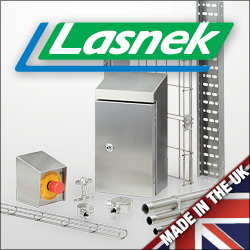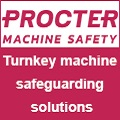
Posted to News on 25th May 2012, 06:37
Fault masking: is your machine as safe as you think?
David Collier of Pilz Automation Technology discusses how fault masking can result in machinery safety systems not being as safe as might be expected, and some alternative solutions to this problem.
There are doubtless many machines in the UK fitted with multiple guards that are monitored in one circuit by safety switches connected in series with dual-channel wiring. Does this sound like one of your machines? And can any of these guards be opened simultaneously?
Historically the practise of series-wired safety switches has arisen because it saved money on cabling and safety relays, and because such dual-channel wiring translated to Category of 3 of the now-withdrawn standard EN 954-1 (for more than one switch in series, EN 954-1 degraded Category 4 to Category 3). Category 3 lives on in the standard EN ISO 13849-1 in which clause 6.2.6 requires that for Category 3 to apply specific conditions must be met which include: a single fault must not lead to a loss of the safety function, that an accumulation of undetected faults can lead to the loss of the safety function and, as an important addition beyond EN 954-1's requirements, that at least 60 per cent of faults have to be detected in a diagnosis mechanism (DC = low).
On closer inspection the ability of a system to detect 60 per cent of dangerous faults can be impacted by a phenomenon known as 'fault masking', which can dramatically reduce the Diagnostic Coverage and, consequently, the Performance Level.
Fault masking
The answer as to how many (if any) switches can be connected in series depends on the faults that can be anticipated (of which there is a list in the validation standard EN ISO 13849-2). The following example of interlocked guards connected in series is intended to illustrate this point.

- The example shows three safety gates connected in series to an evaluation device. Initially all the safety gates are closed and the relay's outputs are 'on', ie the machine can be operated.
- On the left-hand safety gate, a short circuit occurs in the line to the switch with the N/C contact. At first the fault is not detected (because a demand has not yet been placed upon the safety function) and the machine can continue operating (because the guard is still closed).
- The left-hand safety gate is then opened, an event that the left switch signals to the relay. During feasibility comparison of the two switches, the safety relay discovers an inconsistency and switches to a fault condition, ie once the safety gate is closed the machine cannot be restarted (but in this case the safety gate is left open).
- Now the right-hand safety gate is also opened. Via these signals the relay once again detects a normal condition. The fault condition is reset, the safety gates can once again be closed from left to right and the machine is ready to restart.
This example illustrates an undetected fault in the safety circuit, which has built up as a result of the clearing of the fault by the simultaneous opening of two gates. An additional, subsequent fault could cause the whole interlocked guard system to fail to danger (eg another wiring fault occurs, a guard is opened and the machine does not stop). While this is in line with Category 3 (an accumulation of undetected faults can lead to a loss of the safety function). these and similar faults are described by the term 'fault masking'. In the current standard EN ISO 13849-1, the maximum diagnostic coverage (DC) that the switch can achieve is restricted, depending on the masking probability.
In practice, a single switch pair that is evaluated by a safety relay can achieve a DC = 99 per cent. Based on this premise, in the current draft of EN ISO 14119, the maximum DC for a group of interlinked switches is dependent upon the number of switches connected in series and their frequency of operation. Note that at some point ISO 14119 will replace the current standard for interlocking, EN 1088.
As can be seen in the table below, masking restricts the maximum achievable DC and PL.

From the above, if you can show that no two guards are moved with a frequency of greater than once an hour, or there are no more than four of them in series, the statistical chance of a fault occurring and being masked is reduced; however, the Diagnostic Coverage of the system is reduced from 99 per cent to 60 per cent (low), which, in terms of EN ISO 13849-1, means the best PL achievable is PL d, which also means Category 3 has been met.
If you find that more than one guard can be moved with a frequency of greater than once an hour, or there are more than four of them in series, the statistical chance of a fault occurring and being masked is high and the result is that Diagnostic Coverage is reduced to less than 60 per cent (according to EN ISO 13849-1, this is equivalent to no DC). Under these circumstances, according to EN ISO 13849-1, the best achievable PL is PL c (or Category 1 in old terms). If the original risk assessment required Category 3, under these circumstances the system is no longer compliant.
Is there a cure for fault masking?

Devices with RFID coding and OSSD outputs
Some manufacturers of safety components, including Pilz, deploy this technology in their products. Other than the capability to avoid fault masking, RFID-based non-contact switches also offer less troublesome switching (when compared to magnetic types) through various actuator approach angles, and better resistance to defeat through the use of varying degrees of coding (all the way to unique actuator/receive pairs), and better protection against ingress (when compared to mechanically actuated switches). Pilz has adopted this technology in a wide range of its devices.

These are RFID-based guard position monitoring devices with self-monitoring OSSDs. PSENcode switches achieve the highest level of manipulation protection by transmitting a unique code from the actuator to the switch (key lock principle).

These wear-free solenoid locks feature built-in RFID guard position monitoring with self-monitoring OSSDs. They are designed for universal use, even on applications requiring the highest safety standards.

This is an all-in-one system that combines solenoid locking, command-to-release, emergency stop, emergency release to enable a person to escape from inside the hazard area, and RFID guard position monitoring with self-monitoring OSSDs.

These are inductive safety sensors for safe position monitoring (eg robot home position) with self-monitoring OSSD outputs. They are suitable for tasks with long cams or where several positions are to be detected.
An alternative: distributed I/O

Where enclosures cannot be used for IP20 I/O modules, IP67 I/O modules can be conveniently placed directly on the machine (such as Pilz PDP67 F 4 Code and PDP67 F 8DI ION). These modules can be cascaded across a machine on one multicore cable back to the main control panel without degradation of DC or PL thanks to the use of coding or test pulses (see diagram below right).

Emergency stop switches in series
It should be noted note that series connection of emergency stop devices (E-stops) is unlikely to incur a loss of Diagnostic Coverage, based on the fair assumption that it is unlikely that any two switches will be actuated simultaneously or as frequently as once per hour. Therefore it is reasonable to wire such devices in series. However, it is generally inadvisable to require emergency stop devices to perform to PL e simply because they are not intended as primary protective devices; if a hazard requires a safety-related control function to perform to PL e, other primary means of safeguarding should be used.
Training
Diagnostic Coverage (the underpinning issue in fault masking) is a parameter from the current standard EN ISO 13849-1, for which Pilz runs a popular training course Safety design incorporating EN ISO 13849-1 / EN 62061 and the Four-Day City & Guilds Machinery Safety course.
Conclusion
Fault masking is a real issue, even if you do not refer to current or future standards but just apply basic logic. Designers of safety guards and associated circuits on new machines, and those responsible for existing machines in use, should review whatever safety guard circuits they have if these circuits include series-connected safety switches. To avoid the potential problems associated with fault masking, the technology is readily available.
For more information, follow the links above or go to www.pilz.co.uk and use the following webcodes: PSENcs 5184; PSENini 6256; PSENslock 5193; PSENsgate 6474; PDP67 6557; and PNOZmulti 5245.



















